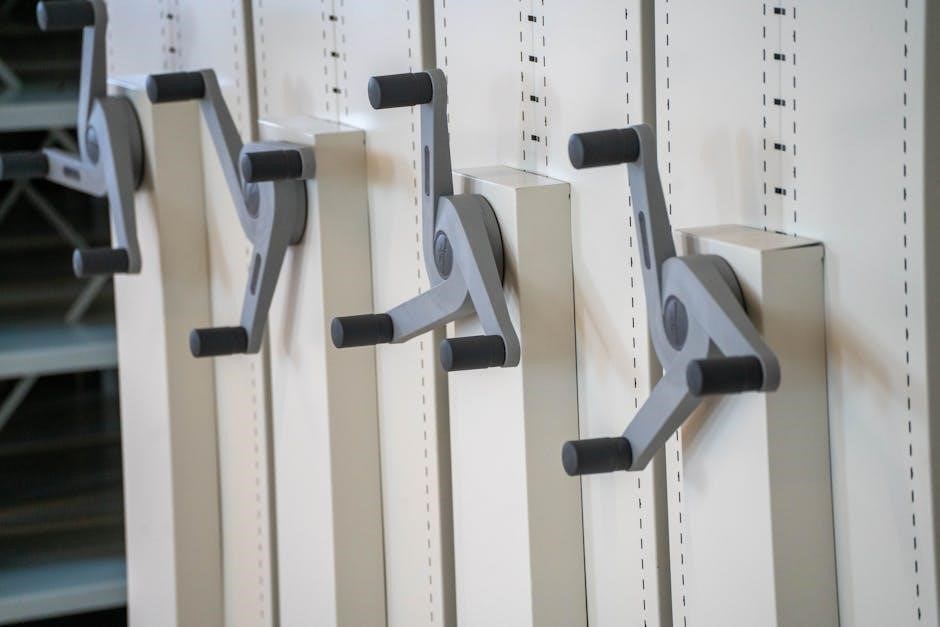wheel torque guide

Wheel torque refers to the rotational force applied to wheel nuts or bolts, crucial for ensuring safety, stability, and optimal vehicle performance. Incorrect torque can lead to wheel loosening or damage.
1.1 What is Wheel Torque?
Wheel torque is the rotational force applied to wheel nuts or bolts to secure the wheel to the vehicle. It is measured in units of force such as foot-pounds (ft/lbs) or Newton-meters (Nm). Proper torque ensures the wheel is safely attached, providing stability, handling, and preventing damage. Insufficient or excessive torque can lead to loose wheels or stripped threads. Torque specifications vary by vehicle, wheel type, and load capacity. For example, passenger cars typically require lower torque than heavy-duty trucks. Understanding and applying the correct torque is essential for safety and performance. Always refer to the manufacturer’s guidelines for precise specifications, as improper torque can compromise vehicle integrity and safety. Regular checks are recommended to maintain optimal torque levels.
1.2 Brief History of Wheel Torque
Wheel torque has evolved alongside advancements in vehicle design and safety standards. In the early 20th century, as automobiles became widespread, the importance of securing wheels with precise force grew. Initially, torque specifications were determined through trial and error, with mechanics relying on experience rather than standardized guidelines. By the mid-20th century, manufacturers began providing detailed torque specifications for wheel nuts, recognizing the critical role of torque in preventing wheel failure. The development of torque wrenches in the mid-20th century revolutionized the process, enabling precise application of force. Today, digital torque tools and automation further enhance accuracy, ensuring safety and reliability in modern vehicles. This evolution underscores the growing importance of wheel torque in maintaining vehicle integrity and performance over time.

Importance of Proper Wheel Torque
Proper wheel torque ensures safety, stability, and prevents issues like wheel loosening or damage. It protects wheel components and maintains optimal vehicle performance and control on the road.
2.1 Why Proper Torque Matters
Proper torque ensures wheel safety and stability, preventing potential hazards like wheel detachment while driving. It secures the wheel in place, distributing force evenly and maintaining vehicle control. Additionally, correct torque protects wheel studs and brake components from damage caused by over- or under-tightening. Proper torque also enhances overall vehicle performance, ensuring optimal braking and handling. Neglecting accurate torque specifications can lead to costly repairs and compromised safety. Always refer to manufacturer guidelines for precise torque values to ensure reliability and prevent mechanical failures. Proper torque is essential for both passenger vehicles and heavy-duty trucks, making it a critical maintenance step for all drivers.
2.2 Consequences of Incorrect Torque
Incorrect torque can lead to severe consequences, including wheel detachment, brake failure, and loss of vehicle control. Over-torquing may strip threads or damage studs, while under-torquing can result in loose wheels, increasing the risk of accidents. Improper torque compromises safety, as wheels may detach while driving, endangering lives. Additionally, it can cause uneven brake rotor wear, reducing braking efficiency. Incorrect torque also leads to costly repairs, such as replacing damaged wheels, hubs, or brake components. In extreme cases, it can void manufacturer warranties or lead to legal liabilities. Always adhering to recommended torque specifications is crucial to avoid these risks and ensure safe, reliable vehicle operation.
Tools Needed for Measuring Wheel Torque
Essential tools include torque wrenches (click-type or beam-type), torque multipliers for high-torque applications, and adapters for compatibility. Wheel chocks and jack stands ensure safety during torque adjustments.
3.1 Torque Wrenches: Types and Usage
Torque wrenches are essential tools for applying precise rotational force. There are two main types: click-type and beam-type. Click-type wrenches emit a audible click when the set torque is reached, ensuring accuracy. Beam-type wrenches use a deflecting beam to indicate torque levels, offering a visual confirmation. Both types require calibration for accuracy. Click-type wrenches are more common due to their ease of use and clear feedback. Beam-type wrenches are preferred for lower torque applications and are often more durable. Proper usage involves setting the desired torque, securing the wrench to the bolt, and applying force until the torque is reached. Regular maintenance and storage are crucial to maintain their precision and longevity.
3.2 Torque Multipliers and Adapters
Torque multipliers and adapters are essential for increasing the range of torque wrenches. Multipliers amplify the applied torque, making them ideal for high-torque applications like heavy-duty trucks. Adapters ensure compatibility with various bolt sizes and patterns. Torque multipliers come in types like gear-driven or hydraulic, offering precise amplification. Adapters are available for different vehicles, ensuring a secure fit. Together, they enhance versatility and accuracy. Proper use requires matching the multiplier ratio to the wrench’s capacity. Always follow manufacturer guidelines to avoid over-torqueing. These tools are cost-effective solutions for applications exceeding standard wrench limits, ensuring safe and efficient torque application across various vehicles and machinery. Regular inspection is crucial to maintain their performance and reliability.

Understanding Torque and Its Applications
Torque is a rotational force that ensures wheels are securely fastened. Proper torque application is critical for safety, preventing wheel loosening, and maintaining vehicle stability and performance.
4.1 How Torque Affects Wheel Safety
Proper wheel torque is essential for ensuring safety on the road. It prevents wheels from loosening over time, which could lead to detachment and accidents. Over-torquing can damage threads or reduce clamping force, compromising safety. Under-torquing may result in loose wheels, increasing the risk of failure while driving. Correct torque ensures even clamping force, maintaining wheel integrity and stability. Improper torque can cause uneven stress on wheel components, leading to premature wear or failure. Always use a torque wrench and follow manufacturer specifications to guarantee safety and reliability. Proper torque practices are critical for protecting both the vehicle and its occupants.
4.2 Torque vs. Tension: What’s the Difference?
Wheel torque and tension are closely related but distinct concepts. Torque refers to the rotational force applied to a bolt or nut, measured in foot-pounds or Newton-meters. Tension, on the other hand, is the clamping force created by this torque, holding components together. While torque is the action applied, tension is the resulting force. Proper torque ensures the correct tension, critical for wheel safety and performance. Incorrect torque can lead to insufficient or excessive tension, risking wheel loosening or damage. Understanding this relationship is vital for ensuring bolts are tightened safely and effectively. Torque wrenches measure torque, while tension is indirectly achieved through precise torque application. Both are essential for maintaining wheel integrity and preventing failures.

Safety Tips for Applying Wheel Torque
This section emphasizes the importance of proper torque application for safety and stability. It provides tips to avoid injury and ensures wheels are securely fastened, minimizing risks.
5.1 Pre-Torque Checks: What to Look For
Before applying torque, inspect wheel studs and nuts for damage or rust. Ensure all components are clean and free from debris. Check the torque wrench for calibration and accuracy. Verify that the vehicle is on a level surface and apply the parking brake. Look for any signs of wear or damage on the wheels or hubs. Ensure the correct socket size is used to avoid rounding nuts. Consult the vehicle’s manual for specific torque specifications and patterns. Perform a visual inspection of the brake rotors and ensure they are free from obstructions. Finally, double-check that all tools are in good working condition before starting the torque process.
5.2 Safe Torque Practices to Avoid Injury
Always wear protective gear, including gloves and safety goggles, when working with tools. Ensure the vehicle is securely supported by jack stands and apply the parking brake. Use a torque wrench specifically designed for wheel torque to avoid over-tightening. Never use impact wrenches for final torque as they can easily exceed specifications. Tighten nuts in a star pattern to ensure even clamping force. Avoid standing in the direction of potential wheel movement. Keep loose clothing and long hair tied back. Ensure the work area is well-lit and free from distractions. Double-check torque specifications in the vehicle’s manual. If unsure, consult a professional mechanic. Never torque wheels while the vehicle is in motion or on a slope. Always re-torque wheels after the first few miles of driving to ensure safety.

Step-by-Step Guide to Torquing Wheels
Gather tools, loosen nuts with a wrench, lift the vehicle, remove nuts, install new ones, tighten in a star pattern, apply specified torque, and double-check tightness.
6.1 Gathering Equipment and Information
To begin torquing wheels, gather essential tools: a torque wrench, adapters, and a multiplier if needed. Protective gear like gloves and safety glasses is recommended. Consult your vehicle’s manual for specific torque specifications, as values vary by make and model. Ensure you understand the tightening pattern (star or sequence) to avoid uneven stress. Verify the condition of your tools and wheels, checking for any damage or wear; If unsure, cross-reference torque values from reliable sources or manufacturer websites. Proper preparation prevents errors and ensures safety. Always calibrate your torque wrench before use for accuracy. Neglecting these steps can lead to improper torque application, risking wheel damage or safety hazards.
6.2 Tightening Sequence and Pattern
Always follow a star or cross pattern when tightening wheel nuts or bolts to ensure even pressure distribution. Start with one bolt, move to the next in a diagonal sequence, and continue until all are snug. Avoid tightening in a circular manner, as this can create uneven stress. For wheels with multiple bolts, divide them into sections, tightening each gradually. If working on a motorcycle or heavy-duty truck, refer to the manufacturer’s specified sequence. Proper tightening prevents warping, ensures safety, and maintains even torque distribution. Never overtighten one bolt before moving to the next, as this can lead to wheel damage or unsafe conditions. Consistency is key to achieving the correct torque specifications.

Common Mistakes to Avoid
Over-torquing can cause wheel damage, while under-torquing risks loose wheels. Always use a torque wrench and follow manufacturer specs to ensure safety and proper wheel integrity.
7.1 Over-Torquing: Risks and Solutions
Over-torquing wheel nuts or bolts can lead to stripped threads, rounded studs, or even wheel bearing damage. This excessive force may also compromise the structural integrity of the wheel hub, potentially causing catastrophic failure while driving. To avoid over-torquing, use a calibrated torque wrench and adhere strictly to the manufacturer’s specifications. If over-torquing occurs, inspect the affected area for damage. Replace any compromised components and re-torque the wheels correctly. Preventative measures include double-checking torque values and employing torque-stick or impact wrenches with careful control. Regular maintenance and inspection can further mitigate risks associated with over-torquing, ensuring both safety and performance on the road.
7.2 Under-Torquing: Signs and Corrections
Under-torquing occurs when wheel nuts or bolts are not tightened sufficiently, leading to loose wheels and potential detachment while driving. Signs include vibrations, rattling noises, or visible movement of the wheel. To correct under-torquing, re-torque the wheel nuts in a star pattern using a torque wrench, ensuring the manufacturer’s specifications are met. Inspect the threads and studs for damage; if compromised, replace them before re-torquing. Preventative measures include double-checking torque values during initial installation and performing regular inspections. Addressing under-torquing promptly is critical to avoid safety hazards and maintain vehicle stability. Always refer to the vehicle’s service manual for accurate torque specifications and procedures.

Vehicle-Specific Torque Information
Vehicle-specific torque specs vary by make, model, and axle type. Passenger cars often require 60-100 ft/lbs, while heavy-duty trucks may need 150-200 ft/lbs or more.
8.1 Passenger Vehicles
Passenger vehicles typically require wheel torque specifications between 60 to 100 ft/lbs, depending on the manufacturer and wheel size. For example, compact cars may need around 80 ft/lbs, while larger sedans or SUVs might require up to 120 ft/lbs. It’s essential to consult the vehicle’s service manual for precise torque values, as under-torquing can lead to loose wheels, while over-torquing may damage threads or wheel studs. Some models also specify different torque values for front and rear wheels. Always use a torque wrench calibrated to the correct range and follow the recommended tightening sequence to ensure safety and even clamping force.
8.2 Heavy-Duty Trucks
Heavy-duty trucks require significantly higher wheel torque specifications due to their larger size and load capacity. Typical torque values range from 150 to 300 ft/lbs, depending on the axle type and vehicle weight. For example, a Class 8 truck might require 250 ft/lbs for steer axles and up to 300 ft/lbs for drive axles. It’s critical to consult the manufacturer’s service manual for precise values, as over-torquing can damage studs or wheels, while under-torquing may lead to loose wheels. Always use a high-capacity torque wrench and follow the recommended tightening sequence to ensure even clamping force. Proper torque ensures safety, stability, and prevents premature wear on wheel components.
8.3 Motorcycles and Bicycles
Motorcycles and bicycles have specific wheel torque requirements to ensure safety and performance. For motorcycles, typical torque values range from 30 to 60 ft/lbs, depending on the make and model. Bicycles, particularly road bikes, often require between 10 to 20 Nm for quick-release wheels. Proper torque ensures rims are securely fastened, preventing wheel wobble or detachment while in motion. Always refer to the manufacturer’s specifications, as over-torquing can damage lightweight components. Use a torque wrench with appropriate adapters for precise control. Regular checks are essential, especially after long rides or rough terrain, to maintain optimal wheel integrity and rider safety on both motorcycles and bicycles.

Manufacturer Recommendations
Manufacturer recommendations are crucial for ensuring wheel safety and performance. Always use a torque wrench and follow the specified guidelines to avoid damage or safety risks. Refer to your vehicle’s service manual for precise torque specifications.
9.1 OEM vs. Aftermarket: Which to Trust?
Choosing between OEM and aftermarket parts involves balancing quality, cost, and compatibility. OEM parts are designed specifically for your vehicle, ensuring precise fitment and reliability. Aftermarket options may offer cost savings but can vary in quality and adherence to manufacturer standards. For critical applications like wheel torque, OEM components are generally more reliable and trusted. However, reputable aftermarket brands can also provide high-quality alternatives. Always verify specifications and certifications to ensure compliance with manufacturer recommendations. Mixing OEM and aftermarket components should be done cautiously to maintain safety and performance.
9.2 Following Service Manuals
Service manuals are essential guides for proper wheel torque procedures. They provide detailed instructions tailored to your vehicle’s specifications, ensuring safety and reliability. Always refer to the manual for torque values, sequences, and tools recommended by the manufacturer. Deviating from these guidelines can lead to wheel damage or safety hazards. Regular updates to service manuals reflect the latest engineering standards, making them indispensable for accurate torque application. By following the manual, you ensure compliance with OEM standards, reduce the risk of errors, and maintain your vehicle’s optimal performance. Consistency and adherence to these guidelines are key to achieving reliable and safe wheel torque outcomes.

Troubleshooting Torque Issues
Common torque issues include vibrations, loose wheels, or over-tightening. Use a torque wrench to diagnose and correct bolt tension. Always consult the service manual for specific solutions.
10.1 Identifying Loose or Over-Tightened Wheels
Loose wheels may cause vibrations, uneven tire wear, or a rattling noise. Over-tightened wheels can lead to warped brake rotors or damage to wheel studs. Check for these signs regularly.
10.2 Fixing Torque-Related Vibrations
Torque-related vibrations often stem from uneven or excessive force applied to wheel nuts. To address this, use a torque wrench to ensure all nuts are tightened to the manufacturer’s specification. Start by loosening all nuts slightly, then re-tighten them in a star pattern to maintain even pressure. If vibrations persist, inspect the wheel and hub for damage or debris. Re-torque the wheels after a short drive, as initial settling may affect torque accuracy. Always refer to your vehicle’s service manual for precise instructions to avoid further issues.
Maintenance and Inspection
Regularly inspect wheel torque to ensure safety and performance. Re-torque wheels after tire changes or long trips, following manufacturer guidelines to maintain proper torque integrity.
11.1 Regular Checks for Torque Integrity
Regular checks for torque integrity are essential to ensure wheel safety and performance. After tire rotations or long trips, re-torque wheels following manufacturer specifications using a torque wrench. This prevents loosening, which can lead to accidents. Always refer to your vehicle’s service manual for precise torque values. Inspect bolts for wear or damage and replace if necessary. Torque checks should also be done after initial installation of new wheels or tires. Proper maintenance ensures even stress distribution, preventing wheel stud damage and enhancing overall vehicle stability. Consistency in these checks is key to maintaining safety and reliability on the road.
11.2 When to Re-Torque Wheels
Re-torquing wheels is necessary after specific events to ensure safety and performance. Always re-torque after tire rotations, wheel replacements, or brake repairs to maintain proper specifications. Long road trips or extreme temperature changes can cause bolts to loosen, making re-torquing essential. If you notice vibrations or uneven tire wear, check and re-torque the wheels. Seasonal tire swaps also require re-torquing to ensure accuracy. Use a torque wrench and consult your vehicle’s service manual for precise values. Regular re-torquing prevents wheel stud damage and ensures even clamping force, critical for stability and safety on the road. Always double-check torque after initial tightening and during routine maintenance.

Future Trends in Wheel Torque Technology
Advancements include smart torque wrenches with real-time monitoring and automated systems for precise, error-free tightening. These innovations aim to enhance accuracy, efficiency, and safety in torque applications.
12.1 Smart Torque Wrenches and Digital Tools
Smart torque wrenches integrate advanced technology, offering real-time torque monitoring and digital readouts. These tools often connect to smartphones via Bluetooth, enabling users to set precise torque values and receive alerts when targets are met or exceeded. Some models include data logging, allowing for the storage and analysis of torque applications, which is particularly useful for quality control in industrial settings. Additionally, digital tools can provide guided torque sequences, reducing human error. This technology is especially beneficial for critical applications where accuracy is paramount, ensuring safety and reliability across various industries, from automotive to aerospace.
12.2 Automation in Torque Application
Automation in torque application is revolutionizing industries by enhancing precision and efficiency. Robotic systems equipped with torque wrenches can apply consistent force, minimizing human error. These systems are particularly valuable in high-volume manufacturing, where repetitive tasks can lead to fatigue. Automated solutions also integrate with data systems, providing real-time monitoring and documentation. Sensors detect even slight deviations, ensuring compliance with specifications. In automotive assembly lines, automated torque tools are used for wheel installation, reducing production time and improving safety. This technology is also being adopted in aerospace and heavy machinery, where precise torque application is critical for reliability and performance.